
Sighişoara — Budapest
By Train from Romania to Hungary
by Train
The next stage of our trip was an overnight train from Sighişoara, Romania, to Budapest, Hungary. This is part of the Athens to Paris by Train series. We would get on a EuroCity overnight train that had left Bucharest around dinner time, boarding the train as it passed through Sighişoara around midnight and arriving at Budapest in the morning. The EuroCity trains are international trains. The EuroNight ones run overnight with sleeper and couchette cars.
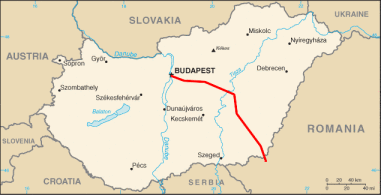
In red: The rail route from the Hungarian border to Budapest.
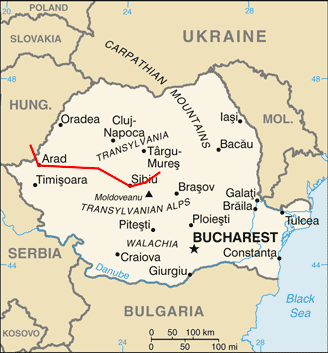
In red: The rail route from Sighişoara to the Hungarian border.
Tickets were 123.70 Lei per person. Then I had a couchette bunk for an added 64.50 Lei, and the others had two two-person sleeper compartments for an added 361.20 Lei per compartment.
That is, 188.20 Lei for the trip including a couchette bunk, and 304.30 Lei per person in two-person sleeper compartments. Or US$ 57.20 and 92.49 at the time.
I had purchased the tickets in Bucharest while also setting up the Bucharest to Gura Humorului segment of the trip.
| EuroNight EC472 Ister | |
| 1745 | Bucuresti Nord Gară |
| 1827 | Ploiesti Vest |
| 1851 | Campina |
| 1930 | Sinaia |
| 1948 | Busteni |
| 2024 | Predeal |
| 2113 | Braşov |
| 2348 | Sighişoara |
| 0142 | Alba Iulia |
| 0258 | Deva |
| 0524 | Arad |
| 0620 | Curtici, Romania |
| 0555 | Lököshaza, Hungary |
| 0618 | Bekescsaba |
| 0633 | Mezöbereny |
| 0645 | Gyoma |
| 0658 | Mezötur |
| 0725 | Szolnok |
| 0850 | Budapest-Keleti |
Amazon
ASIN: 1409369072
Amazon
ASIN: B006JUJ1NM
Magyar, or the Hungarian Language
In the morning we were crossing the Hungarian plain. Known to the Hungarians as Nagy Alföld, it is a rich agricultural region making up a little over 50% of the country.
The very literary Hungarian people say that their authors Ferenc Móra and Zsigmond Móricz and poets Sándor Petőfi and Gyula Juhász were inspired by the plain.
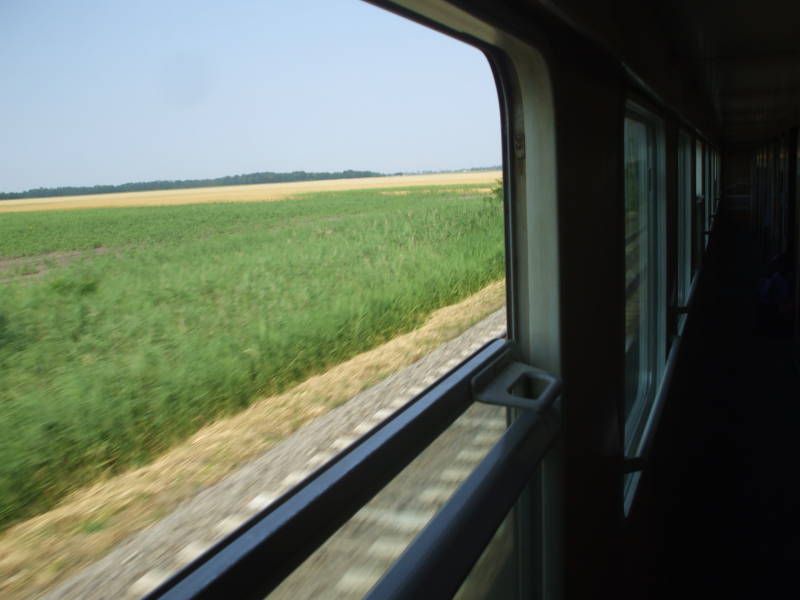
And that gets us into the orthographically challenging Hungarian language, or Magyar as it calls itself...
Check out the name of this festival held on the Great Hungarian Plain: Bajai Halászléfőző Népünnepély or the Fisherman's Soup Boiling Festival, held in Baja. Notice that letter ő, it is an o with a double acute accent: ő is not ö. Magyar has both of those! There is also both ű and ü.
| Hungarian Vowels | |
| a | As in "hot" or "call" |
| á | As in "father" |
| e | As in "less" or "bed" |
| é | As in "café" |
| i | As in "thick" and "thin" |
| í | As in "seed" and "sea" |
| o | As in "force" |
| ó | As in "go" and "snow" |
| ö | As in "curt" but shorter |
| ő | As in "her", longer and more closed than ö |
| u | As in "rude" or "pull" |
| ú | As in "rule" and "fool" |
| ü | As in French "tu" |
| ű | As in "strewn" |
| Hungarian Consonants | |
| b | As in "by" and "boat" |
| c | As in "tsunami" and "cats" |
| cs | As in "church" |
| d | As in "do" |
| dz | As in "kids" |
| dzs | As in "jam" and "George" |
| f | As in "fort" |
| g | As in "go" and "get" |
| gy |
As in Russian "дюна" or French "Dieu" (really!) |
| h | As in "behind" and "human" |
| j | As in "yes" and "you" |
| k | As in "key" |
| l | As in "leaf" |
| ly | As in "yes" and "you" |
| m | As in "maybe" |
| n |
As in "need", except before k and g when as in "thing" |
| ny | As in "lasagna" |
| p | As in "papa" |
| r | As in Spanish and Russian |
| s | As in "ship" |
| sz | As in "sip" |
| t | As in "talk" |
| ty | As in Russian "тюрьма" |
| v | As in "very" |
| z | As in "desert" and "rose" |
| zs | As in "pleasure" and "leisure" |
Amazon
ASIN: 1138949868
Amazon
ASIN: 0743563948
The double acute accent is mainly a Hungarian phenomenon. The only other languages using it were Slovak in the early 1900s as a variant of ä; the Chuvash language of central Russia with its Cyrillic ӳ, equivalent to the Latin ű; and Faroese as a substitute for ø to avoid confusion when classical Danish handwriting is involved. As you can see, these are not mainstream uses for most of us.
There are 44 letters in the Magyar alphabet, with fourteen of them being vowels. Multi-letter combinations, or digraphs and trigraphs, are considered as single letters. D, DZ, and DZS would all have their own chapters in the dictionary.
The letters s and sz are the exact opposite of how they are used in most European languages. And that gy is just bizarre. So the language's name is pronounced in a way that an English speaker might spell Madyuar.
EstoniaHungarian is a Uralic language. Finnish and Estonian are the only other Uralic languages in Europe. Uralic used to be called Finno-Ugric. Hungarian is more specifically a Ugric language. Its closest relations are Khanty and Mansi, spoken in western Siberia by small indigenous populations of about 12,000 and 3,000 people, respectively.
Turkishstudy guide
Hungarian is agglutinative, adding suffixes and prefixes, and enforces vowel harmony. So in some ways it has more similarities to Turkish than to Indo-European languages spoken throughout most of the rest of Europe.
Oh, and its nouns decline through no less than eighteen cases!
We won't be here for long, and it won't be hard at all to get around Budapest without knowing any Hungarian. That's good, as a quick understanding of Magyar just isn't going to happen.
Amazon
ASIN: 0415777372
Amazon
ASIN: B0000CMWTO
Here is a rumpled couchette after a night on the EuroCity train. The couchette compartments are pretty standard. Curtains over the glass in the door. Three bunks on either side with a lightweight ladder to access the upper bunks.
The bunks can be folded up during the day to form three seats facing three more.
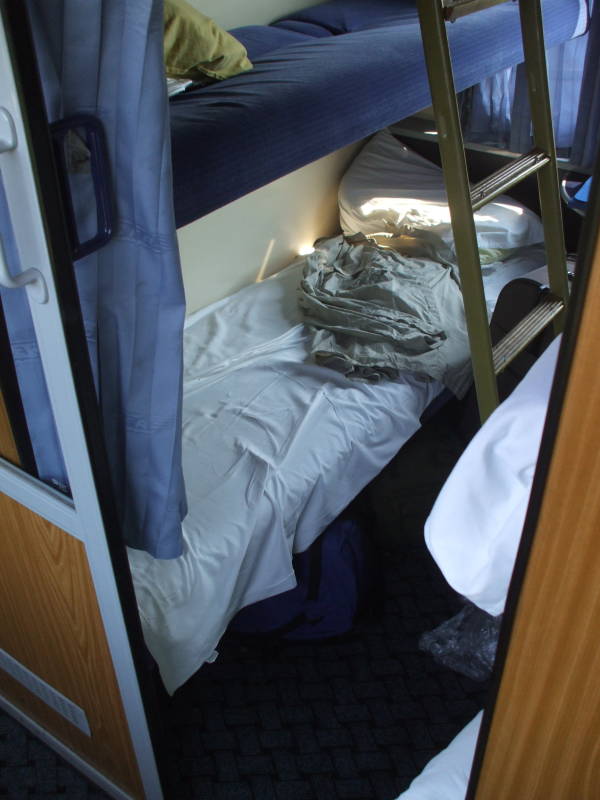
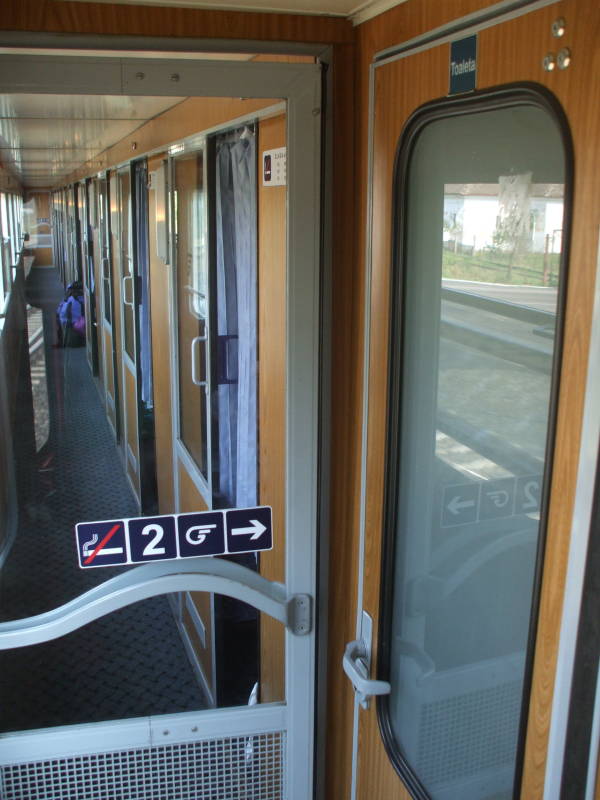
Here are Shirley and Larry in their sleeper compartment. With the reservation made in advance back in Bucharest a week or so before, the two sleeper compartments were already prepared for just two people each when we got on. A middle bunk was left folded up against the wall.
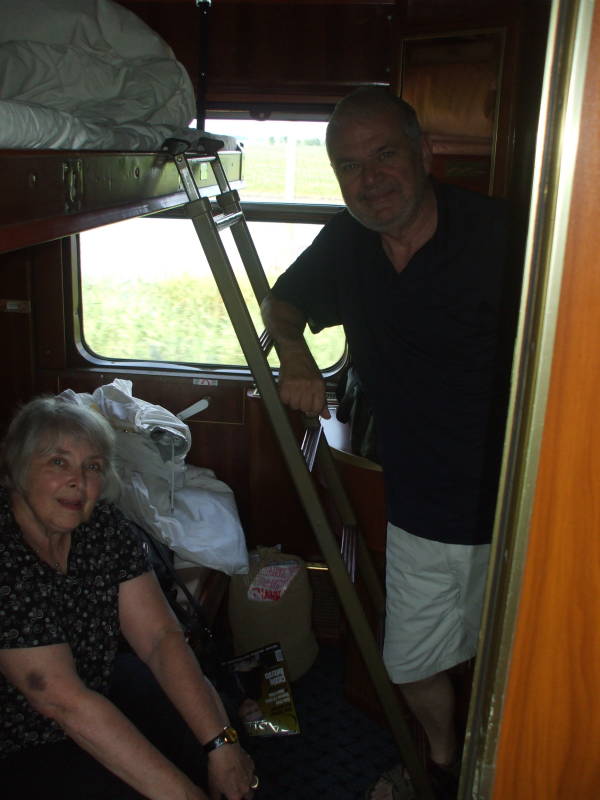
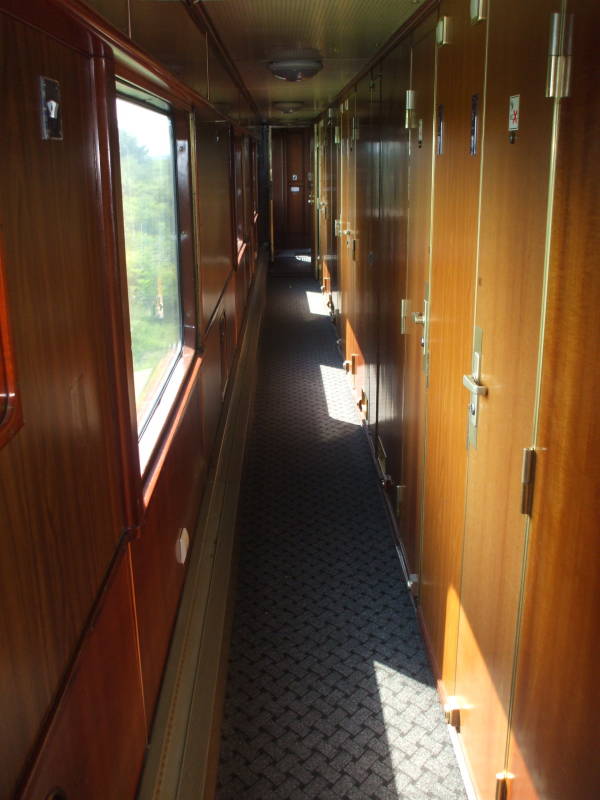
You just need to spot your car number and then make your way to the correct compartment.
My parents have gone to the lounge car for some juice.
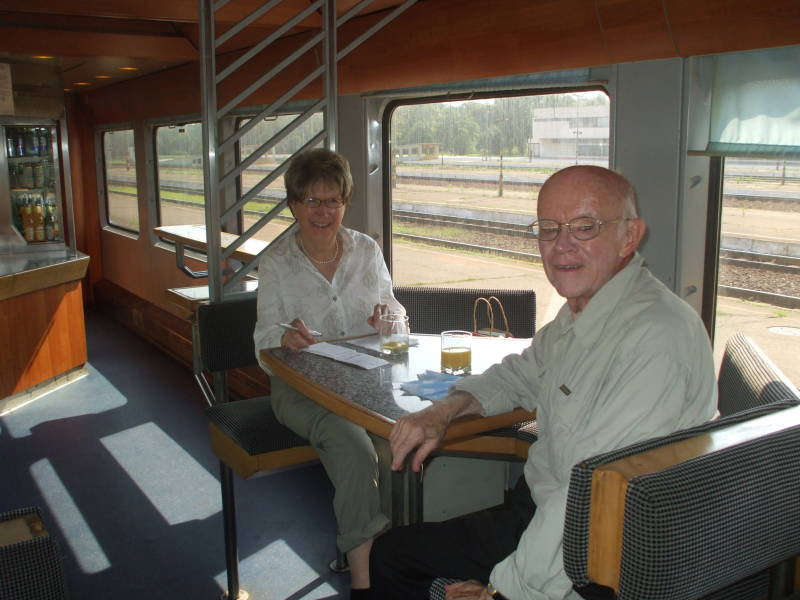
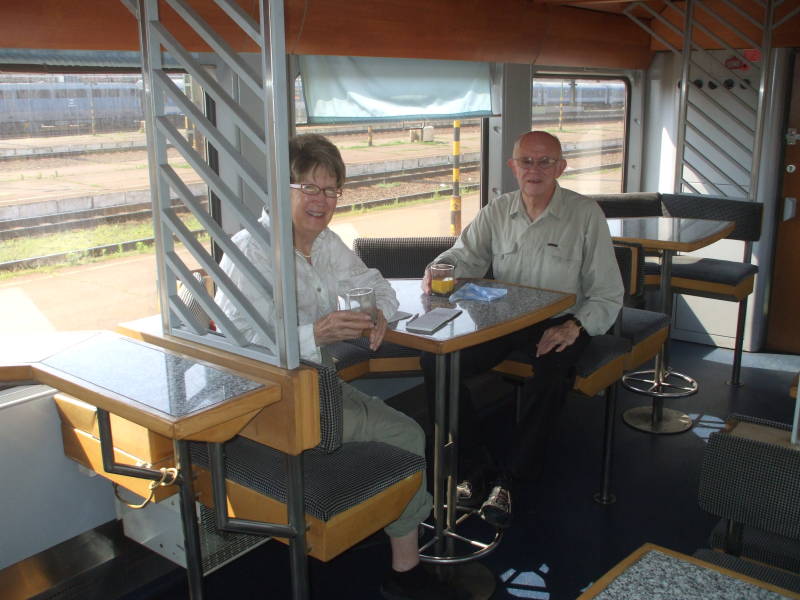
The lounge car has snacks and drinks, not full meals.


We have arrived at Budapest's Keleti pu, short for Budapest Keleti pályaudvar or Budapest East railway station. It's the largest of Budapest's three main railway stations.
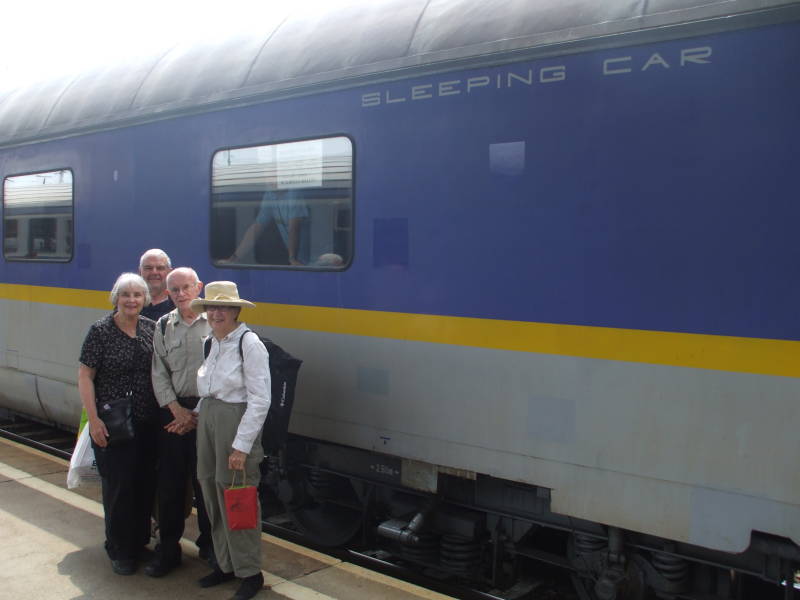
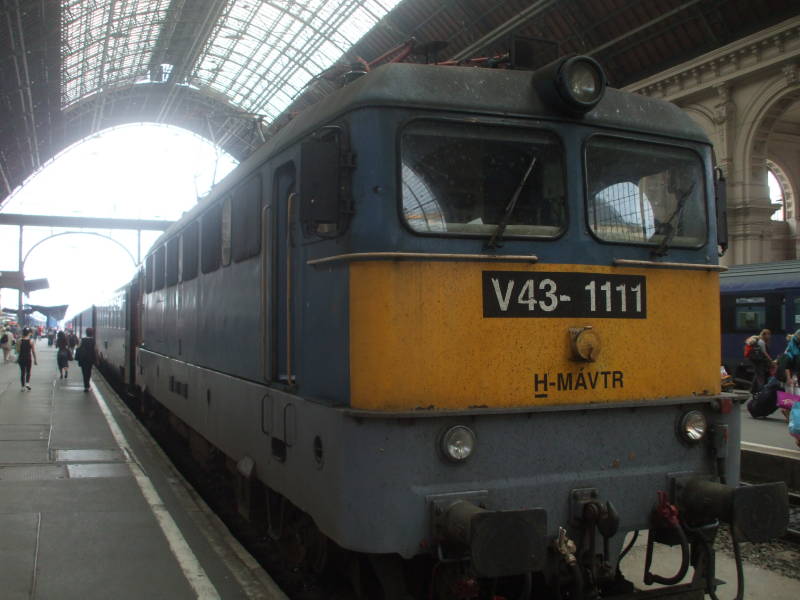
Hungarian abbreviations are, like so many things with the Hungarian language, rather different than I would expect. The abbreviation for pályaudvar is pu and not pá.
Hungarian words for cardinal directions are based on the positions of the Sun during the day. East is kelet, as in keleti pályaudvar, where kelet means "rise". West is nyugat or "set". South is dél or "noon", and north is észak, from éjszaka or "night" as the Sun never shines from the north during the day.
We stayed at Radio Inn
where double rooms were €60:
Benczúr 19
+36-2-342-8347
radioinn.hu
Sightseeing in Budapest